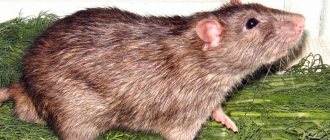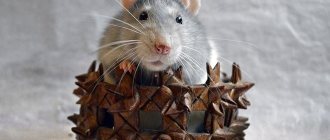Most summer residents and villagers keep chickens to feed their households not only tasty, but also fresh, harmless products. Eggs are used to fry omelettes, make filling for pies, and poultry meat is used for first and second courses. But sometimes rats are able to enter an outbuilding. Rodents bring many problems to owners, so it is necessary to immediately take measures to expel them. How to get rid of rats in a chicken coop, what methods to protect the building from invasion?
The chicken coop is a real paradise for aggressive pests. The building is always dry, and even in severe winter cold it is warm. There is a lot of food here, ranging from full feeders to stocks of grain or animal feed. In addition, rats will never miss an opportunity to profit from chicken eggs. That is why they are able to attack chicken coops with amazing tenacity and inhabit them with lightning speed.
The main reasons for the appearance
The appearance of rats is not without reason. The rodent differs from other pests in its intelligence and cunning. Often the “war” with them drags on for a long time, but this happens due to the wrong approach to exterminating them in a chicken coop, barn or home. You need to start looking for reasons with:
- the condition of the premises where the chickens are kept;
- street conditions (yard);
- the presence of other outbuildings (your own, neighbors’).
If the neighbors do not have order in their yard or sheds, then the rat house may be located there. Individuals come to feast on eggs and other products. It is difficult to immediately determine the location of the rat house. Often the passages reach 500 meters or more.
5 effective ways to permanently get rid of rats in your barn
The second reason: insufficient cleanliness, odors, droppings. Irregular cleaning leads to the spread of odors that predators can hear from a kilometer away. After the first visit to the barn, the rat determines the risks, the number of threats, and the amount of food.
Interesting fact! Disinfection specialists note: a rat can give birth to more than 40 individuals in one year. At the same time, it creates comfortable conditions for the offspring. Therefore, he builds not one, but 2-3 houses, where there are food supplies. This helps protect rat pups from starvation and makes it possible to further expand the family (The most effective ways to get rid of an earthen rat).
How eggs are stolen
Rats pose a danger to chickens and other inhabitants of nurseries due to the spread of infection and parasites. They reduce the offspring of birds by destroying young chickens and eating eggs.
Let's take a closer look at how rats steal eggs. The animals take the egg with their front paws, moving on their two hind limbs.
With its prey, the rodent is able to move not only along the floor, but also along the walls and ceiling. Most often, pests steal birds' eggs in groups, rather than individually.
What harm can they cause?
The more often the gray pest comes to visit, the more traces it leaves. The problem must be resolved immediately. And the sooner the better. Rats reproduce quickly and expand their habitat. As the family grows, the harm increases. This includes damage to walls, floors, and food supplies. As well as storing hay, compost, and other raw materials for work in the field and everyday life for the winter. The most terrible thing is infection with intractable diseases.
Eating and spoiling eggs
It is generally accepted that rodents love raw foods, but the best treat for a rat is an egg. They contain a large number of useful elements that all animals need. Also, eating eggs is not so noticeable. Plus, they are better stored in a den for a rainy day.
Chicken attacks
The Rat is an excellent mother who takes care of her children. Chickens are a delicacy for young animals; it is easier to strangle them in order to pull them into the hole. Rodents can smell tender poultry meat far away. They are capable of killing not only hatched chicks, but also older ones (3-4 weeks old). Within a few days there is a risk of losing the entire brood.
Infection with dangerous diseases
Rats in the chicken coop should be dealt with as soon as signs of a visit are discovered. The rodent is not only harmful in terms of stealing eggs and chicks. Rats carry many diseases on their paws and fur. 50% of them are incurable and lead to death in animals and humans.
Proven fact: rats are capable of transmitting sexually transmitted diseases through household means (biting, staying in the bathroom, gnawing on soap). But this happens rarely, and only in conditions of a widespread “rat epidemic.” A rat bite – how dangerous it is and what to do after a bite, read more in the article here.
The most frequently reported diseases after visiting rats were:
- typhus, plague;
- rabies and toxoplasmosis
- lice, scabies, fleas;
- tularemia and soda, and many other infections that are worth knowing more about.
Rabies
The rat is a dangerous opponent. The older the animal, the more difficult it is to destroy it. It can attack a cat and damage a dog's face. Moreover, there is not a single individual that is not infected with rabies. Naturally, one rodent bite is enough to infect pets. Lethal outcome in 100% of cases.
Plague
Not only researchers, but also ordinary people know about the causes of the outbreak of the plague epidemic in the Middle Ages - these are rats that infested cities and villages. The fight against rats in the chicken coop should be carried out quickly, and the premises should be disinfected without delay and with enviable regularity. The infection is contained in the feces, fur, and saliva of the rodent. A person carries it into the house on shoes, and the chickens eat the grain along with it.
Typhoid
Typhoid infection is practically asymptomatic. The disease is cyclical, location - intestines. The chicken may not show signs of the disease, but salmonellosis (Salmonella bacteria - the causative agent of typhus) will be diagnosed in meat and eggs. Signs: diarrhea, headache, arrhythmia, weakness.
Toxoplasmosis
A parasitic infection slowly kills humans, animals, and birds over a long period of time. There are no symptoms. But the consequences of infection will be myocarditis, lymphadenitis and other diseases that are difficult to treat.
Leptospirosis
Don't set out to catch a rat in a chicken coop. It must be destroyed, but not picked up. If there are wounds, abrasions, or scratches, infection with leptospirosis will occur. The disease is infectious. Transmitted quickly. Affects the liver, kidneys, capillaries. Rapid intoxication of the body occurs. Leads to disruption of the nervous system.
Toxocariasis
The disease is mistakenly equated with ordinary helminth infection. But that's not true. The parasite is not located within the gastrointestinal tract. Its task is to penetrate the blood and spread the infection to organs and tissues. In humans, the signs are vague. It is impossible to determine by the presence of symptoms. Only blood tests will show the true cause of the illness.
Human infection occurs not only from dogs and cats, but from poultry meat and eggs. The reason is the presence of rats in the poultry house.
Parasites
Parasitic infection occurs in 2/3 of the world's population. Most often among those who consume poultry meat. In total there are more than two hundred names of parasites. And they are all spread by rodents (mostly rats). The most dangerous ones are:
- echinococcosis, taeniasis;
- giardiasis, diphyllobothriasis;
- amebiasis, enterobiasis;
- teniarhynchosis and ascariasis.
Only the simplest species do not rise above the intestines. But broad tapeworms, flukes, and Chinese flukes are aimed at “capturing” the entire organism for further consumption. Rats are only carriers of parasites, but they themselves are immune to 95% of infections, microorganisms, and pathogens.
Ticks
There are more than two dozen species of ticks. They wake up at a temperature of -2 and calmly experience the heat and high humidity. Arachnids are invisible, but dangerous, as some of the representatives kill a large dog in 3-5 days. The chicken dies in 1-2 days.
Lice and fleas
If there is a rat in the chicken coop, then after a few days you can notice how the birds and animals are itching intensely. This means it’s time to treat for insects. Fleas are the same carriers of infections and parasites as rodents. It is useless to fight them if you do not remove the main carrier - the rat.
Helminths
You can get rid of rats in a chicken coop without harming the chickens, but you must worm all pets, poultry, and family members. If a rodent appears in the chicken coop, then the food, grain, water and bedding have remnants of the pest's feces. This increases the risk of helminth infection.
Need to know! A person becomes infected not so much from poultry meat and eggs, but from the marks of rat teeth left on food. The animal is fast, able to crawl into hard-to-reach places. The rat doesn’t necessarily want to eat bread, cereal, or flour. All she needs to do is walk through the products and smell them. Infection will occur upon first contact with food.
Using rat repellers
The use of repellers is more humane than the use of poison. Ultrasonic, mechanical and biological devices are commonly used to repel rodents. At the same time, the inhabitants of the poultry houses do not experience any unpleasant sensations. And rats will not come close to the area where such devices are located.
Ultrasound devices.
Such devices are plugged into sockets, but the ultrasound is not perceptible to humans, and the rats in the poultry house lose the ability to navigate in space and lose their appetite. Because of such inconveniences, these animals prefer to move en masse to another place where there will be no such devices.
Mechanical devices.
Typically, specialized stores offer the following mechanical devices for catching rats - traps or rat traps. Food is attached to special pins, and when you try to take it, a mechanism is triggered and the trap is triggered.
These devices can be safely used indoors. Currently, powerful rat traps are sold, which can catch several rodents at a time. At home, they also use homemade traps by spreading special glue on a solid base in front of the food.
Biological agents.
This method is the simplest of all, except for the need to remove dead animals.
To combat rats, their natural enemies are used - owls or cats. Street cats fight rats more actively - real rat traps have an elongated, pointed muzzle.
Signs of pests
You can minimize the consequences and damage caused by the gray “guest” if you monitor the condition of the farm, animals, and birds. The first signs of the appearance of the pest will be restlessness of the hens and a decrease in egg laying. Next, you can observe the carcasses of strangled chicks and a specific smell in the chicken coop. Having noticed this, inspection of the premises and their disinfection should be carried out regularly. The farmer’s main task becomes to protect and rid the farm’s inhabitants from the gray “plague.”
Litter
A rat, even one individual, always leaves litter. The feces are oblong and dark brown in color. Can be confused with mice. But they are larger. The droppings are left mainly in corners or near food.
Interesting fact! A mouse and a rat cannot live under the same roof. If you notice that suddenly all the mice in the area have disappeared, this is the first sign of a rat infestation. It is worth notifying your neighbors about a possible threat, and jointly choosing a way to calculate its location and destroy it.
New holes
The rat makes new moves for escape and escape. It is important for the animal to have several such “doors” so that it can escape when meeting a person. The sounds that the rodent makes are quite loud and can be heard even in the chicken coop. Almost every day the rat adds a new hole in the floor, walls and doors of the poultry house.
Strangled Juvenile
During the first few weeks, the rat settles in and prepares an escape route. Then he starts stealing eggs, i.e. something that is less noticeable. But the longer she runs the chicken coop, the more she allows herself. If a strangled chicken is found on the floor, it’s time to sound the alarm, set traps and bait to catch the pest.
Damaged wires
Not necessarily, but in 80% of cases, problems with electricity may arise in household plots and agricultural buildings. Any damage to the wire means the presence of a rat.
Specific smell
Sudden change in odor in the room. It is more sugary, with a bright ammonia hue. Enhances amber in corners and less ventilated areas.
Why do they appear?
The chicken coop, especially in winter, is a desirable haven for rats.
This is explained very simply:
- chicken room In addition, gray robbers are very keen on chicken eggs and even young chickens;
- the comfortable microclimate created by humans in a chicken coop is also ideal for the rat community. The better the poultry farmer takes care of the chicken coop, the more grateful the rats are to him for this;
- are attracted to the poultry house by the specific smell that they associate with delicious eggs and chickens;
- greatly facilitates the penetration of rodents into the chicken coop by the presence of special holes in it for chickens.
Basic methods of struggle
There are ways to get rid of rats in a chicken coop forever, both with folk remedies and with the help of chemicals. The quickest solution to the problem is to seek the help of a professional disinfection service. The method is expensive, but works flawlessly. The arsenal of such enterprises includes a lot of effective means that will not harm poultry or other animals. Due to the high cost of the service, residents of the private sector carry out pest control on their own, using all available options at once.
10 effective ways to catch a rat
Chemicals
There are a lot of drugs that can poison rodents. But not all of them have the ability to remove rats forever without harming the chickens. Any poison is a risk for a large poultry farm. The substance will become available literally immediately, spreading on its paws throughout the entire room. Hence the need to move the chickens to another place while working with chemicals. For etching, you can use a quick-acting agent. Krysin is popular, but there are other poisonous baits, substances, and solutions.
Poison bait
Rats are a real threat to households and modern life. The animal reproduces intensively, develops new territories, and has a high level of intelligence, which makes “war” with it difficult. The chemical industry offers the use of numerous poisons for disinfection. At the same time, the drugs perfectly mask odors that attract pests.
When etching a room, you should be careful and use protective clothing and gloves. Upon contact with human skin, substances penetrate the body through the skin. They help remove rats from the chicken coop, but if used incorrectly, there is a risk of exterminating all the birds and animals on the farm.
The following types of poisons are offered:
- granules;
- pills;
- grains;
- powder;
- gel-like substances.
Most poisonous products require dissolution in water and mixing with food products (porridge, minced meat, flour, cereals, etc.). But there are also those that are ready to use without any extra effort (they put it in a hole).
Important! A prerequisite for purchase: check the expiration dates and the presence of instructions for use.
The most popular baits are those that mummify rodents. Reason: the poison does not always act instantly, which means the rat will die later. The result will be an unpleasant odor due to the decomposition of the corpse.
Goliath
It goes on sale in different packaging: from 1 to 10 kg. Intended for industrial use, but recommended for the private sector. A kilogram package is enough to treat several private properties.
Ratid-1
The bait is ready to use. Its appearance: grain mixture. The main component of the drug is diphenacin (2nd generation anticoagulant). The death of the pest occurs 5-10 days after eating. It is convenient because within the specified period of validity it is eaten by a whole brood of rats, since it is considered a safe product.
Krysid
Using this method to poison rats is simple and quick. The substance is toxic only to animals. It does not pose a particular threat to humans, but one should not deviate from safety measures. The death of a rat occurs after a maximum of 3 days, at least after 12 hours. Includes use:
- spraying inside the hole;
- mixing with food (it is recommended to put the stash directly into the hole);
- stirring in water or milk.
Since the task of the owner of a chicken farm is to protect the poultry, the Rat is quite suitable for safe use in a chicken coop.
Storm
The drug is quite cheap and effective in the fight against rats. Sold in briquettes individually and in sets of 4 pieces. There are also packages with pellets (granular substance) and in containers up to 16 kg.
Mortorat
With the help of this substance you will not have to search for and remove rodent corpses. The drug mummifies them. It differs from other baits in its high efficiency and safety of use.
Appearance: a briquette with a gel-like substance, carefully packed so that there is no contact with the skin (it is better to use gloves when working). A hole is laid in the hole and then sealed with plaster or cement. There will be no one left to damage the walls.
Rat death
Purpose: large-scale persecution of all types of rodents. The Italian manufacturer guarantees quick freedom from pests. Sold in two versions. Difference in composition:
- first option: the main component is brodifacoum;
- second type: the basis is bromadiolone.
You will need auxiliary components: mixing with minced meat, porridge or cereals.
Ratindane
The bait is effective. Used only in combination with additional ingredients (food). Methods of use: pollination, dilution in liquid or with food.
Repellers
A humane way to deal with the threat of rat attacks is to use ultrasonic, mechanical or biological repellers. In addition to preventing pests from approaching the chicken coop, the devices do not interfere with the quiet life of the farm’s inhabitants.
Ultrasound
The device is connected to the power supply. The sound is inaudible to humans, but the rodents lose orientation and refuse food. Since animals love comfort, due to the inconvenience created by ultrasonic repellers, they leave their place of deployment in search of new housing.
Mechanical
To eliminate rats, stores offer mechanisms for physical influence: rat traps, traps. Products are attached to a special compartment. When you try to take food, the mechanism is triggered and kills the rodent.
The method is safe to use indoors. At one time, with modern mechanical traps, you can catch several individuals at once. The price (from 200 to 1000 rubles) will suit everyone, since there are more than a dozen types of such products. Homemade version of the trap: glue applied to a thick base before eating.
Biological
The cheapest and does not require additional effort other than cleaning up the pest’s corpses. Involves the use of other animals: owls, rat-catching cats. Most often these are street cats. Their ability to catch rodents can be determined by their muzzle: pointed, extended forward.
Traditional methods
In addition to chemical and mechanical baits, private property owners use folk remedies to repel and catch rats. Some of them are humane, but most eliminate the threat. The main thing that is being relied on is that there is no significant threat to hens and chicks, since the technique ensures safety for the birds.
Medicinal black root
Rats have an overly heightened sense of smell. Therefore, they can hear smells a kilometer away from their homes. Since ancient times, medicinal black root has been used to repel. It acts on animals and birds in the same way as on a pest. They are not suitable even for the sake of interest in the plant. In emergency situations, when a rat has already visited the chicken coop, grass is laid out in the corners of the barn, around it. Both dry and fresh plants are suitable.
Wood and stove ash
Materials such as wood and stove ash are used as a fertilizer mixture in the garden. But it has an additional positive quality: it destroys rats. No additional ingredients are required to prepare the deadly drug. Simply scatter it around the chicken coop (pre-transfer the bird to another building) in a layer of 1-2 mm. Ash is very sticky. Therefore, it will remain on the fur and paws of the rat. Once in the stomach, it begins to corrode it, causing pain. Death occurs 2-3 days after ash enters the rat’s body.
Alcohol
The method of removing rats using alcohol does not always work correctly. Provides for diluting vodka, alcohol, homemade alcohol in water. Place it closer to the holes so the rat can drink. After which she quickly falls asleep. There is no time to waste: a drunken pest is killed on their own.
Gypsum and lime
To prepare the bait, choose one of the building materials: gypsum or lime. Combine with corn flour (in equal proportions). Using milk or kefir, make dough and roll out balls. We leave the blanks near the holes, in places where there are large concentrations of rats. When baits disappear, add new ones.
Autumn colchicum
A highly toxic plant. Collect only yourself, as it is not sold anywhere. Work must be carried out with gloves. To use as a poison, 200 g of seeds or a food mixture with the addition of 10 g of grass is sufficient.
Flour with alabaster
The two components are mixed in equal proportions. Pour into saucers, place in corners and near holes. A container of water must be placed nearby. While eating the alabaster mixture, the rat will drink water. Hardening of the material in the stomach takes a minimum of time.
Need to know! All folk methods (except for repelling with plants and rat-catching cats) require the use of luring or baiting tactics. It consists of the following: in places where baits with deadly mixtures will be placed, milk, bread and other products without poison are initially placed. The rat must get used to the safety of this place.
Wine cork
The dry wine cork is crushed and mixed with bread crumbs. To improve the bait, the resulting substance is generously moistened with unrefined sunflower oil. Result: the plug in the rat's stomach will gradually swell and get stuck. Leads to death after 5-7 days due to the inability to eat anymore.
Elder
It is recommended to plant elderberries immediately before breeding poultry and livestock. You can regularly place the plant inside and outside the building. It works better as protection if you place wormwood and squeezed garlic in the opposite corner and near rat holes.
Mint
The grass has a strong odor that is pleasant to humans, but is intolerable to most animals, including rats. Method of application: plant around a plot of land, barn and other buildings. In extreme cases, regularly make a strong decoction and spray it on holes and the room where chickens are kept.
Turpentine or kerosene
The strong smell of the substances repels rats from the chickens’ habitat. It is considered a humane species, as rodents no longer visit barns. Turpentine or kerosene is applied in a small layer to the walls and floors of the room. Regular application at least 3 times a week. During processing, the bird is transferred to another place.
Naphthalene
The principle of using naphthalene is similar to the previous one: generously lubricate the cracks, holes and walls of the room. The number of applications and duration of treatments depends on the number of rats.
How to protect birds and animals when using poisons
When destroying rodents with pesticides, it is necessary to remember that not only rats can suffer. The poison is also of interest to chickens. They will also want to try it, so you need to place the poison in places inaccessible to birds and pets. A poisoned rat is also dangerous. A cat can eat it, after which it will most likely die too. To ensure the safety of chickens and animals, you must follow a few simple rules:
- If using poison, move the chickens to another house or separate room. Place a poisonous substance in the barn with rodents. After the death of the rats, thoroughly clean the room. Check for dead rodents under the hay. Remove the old flooring with any remaining poison and cover it with a clean one, and only then place the birds back into the coop.
- If you don't have a spare coop, you can use another chicken-safe method. Place the poison in a wooden box, preferably one with a hinged lid. Make through holes in it so that the rodent can get inside. There should be two holes, because if there is no way out of the box, the rat will not climb into a closed room. Having caught the delicious aroma, the animal will run into the box. Neither chickens nor other animals will be able to get inside and will remain safe. To prevent the box from falling or being overturned by birds, place something heavy on it.
- Provide chickens with a metal mesh enclosure. Install protection not only on the sides, but also on the top.
Prevention measures
In order not to think about how to remove rats from the chicken coop, you should prevent their appearance. For this:
- regularly clean and clean the poultry house;
- monitor the condition of the walls and floors of the room;
- carry out prevention using traditional methods or chemicals in a manner that is safe for the bird.
Rat poison
Any of the poisons is suitable as a preventive measure (Rat poison for mice and rats: how it works and which is the most effective, read the article here). To do this, if any holes or cracks are found in the floor and walls of the chicken coop, the selected product is sealed into them. Repellent plants are popular: elderberry, mint, wild rosemary and others.
Glass and crushed stone
Spring work on landscaping agricultural buildings and houses will help prevent the appearance of rats. Prepare a mixture of crushed stone and broken glass. Sprinkle around the perimeter behind the barn, and additionally seal into new cracks in the building. Glass shards injure the animal, which creates discomfort for existence. Rats will no longer go to such places.
Chicken coop walls
For the safety and comfortable keeping of chickens, it is advisable to reconstruct the barn. You won't need to spend a lot of money. It is necessary to purchase glass wool and embed it in the walls and floors. This is excellent thermal insulation and protection against rodents of all types.
Important! You can tear off the floors in the chicken coop and when laying new ones, make the bottom layer from a mixture of ash, crushed stone and glass.
Animals
A representative of the cat family is suitable as a prophylactic agent. For these purposes, a mongrel animal is suitable, but with an elongated nose. Or buy Sphynx or Siberian cats. The reason for these recommendations: most cats are afraid of rats. That's why they don't even approach them.
Precautionary measures
When dealing with rats using chemicals, do not forget to take the following precautions:
- Wear protective gloves when preparing and handling the product.
- Do not use near other foods, children, or pets.
- Wash your hands thoroughly with soap after completing procedures.
- Remove poisoned corpses in a timely manner.
Use chemicals with a mummification effect to avoid breathing in the smell of decomposition, as the rat may die in a hard-to-reach place.
Ferret habitat
The ferret is a predator. It settles almost everywhere, but prefers to live on the edges of the forest, so that there is a body of water nearby. Ferrets live in burrows that they make themselves, or they occupy burrows made by other animals and abandoned by them.
The ferret is difficult to find in dense forests; the animal does not like too dense forests. Animals prefer small forests or groves located near human habitation. The ferret does not like to wander from place to place. This is what distinguishes males: each of them has its own strictly defined territory and it is extremely undesirable for them to appear in a foreign area. Females are more loyal in this regard: they can live anywhere and not feel much discomfort. A male can walk about 5 km per night - this suggests that their hunting grounds are very extensive.
Ferrets' burrows are not very deep, usually there is one tunnel and a nesting site at the end. Ferrets can make their shelters in abandoned burrows of badgers and foxes. Sometimes a ferret settles right next to a person. Here he will probably have a nest in some barn, but in a secluded place. Usually, forest ferrets climb into barns, because steppe ferrets try to avoid human habitation.
The steppe ferret lives almost in open areas. In terms of area of settlement, the steppe ferret surpasses any other steppe animal. In the steppes, ferrets make abandoned gopher burrows for themselves. Such a hole can save the animal from both the summer heat and the winter cold. There is no way to live without a hole in the steppe: you can easily become the prey of another, larger predator. Steppe ferrets do not have a strictly defined territory.
Weasel
Who else strangles chickens in a chicken coop besides a ferret?
The charming weasel does not disdain this activity. Looking at this cute creature, it’s hard to believe that it is absolutely fearless. A weasel is capable of defending itself to the last, attacking a person and injuring him quite severely. And this despite the size of the predator. Her teeth are sharp, like needles. This animal is very cruel. The weasel destroys its prey with “special cynicism.” It attacks with lightning speed, strangles, and then tears into pieces and eats. Having had enough, he continues his hunt. Therefore, the owner, coming to the chicken coop in the morning, will find many strangled birds.
The weasel is fast and agile. It is almost impossible to catch it on your own.
Repellent methods
Along with folk remedies, repellers help get rid of ferrets in the chicken coop. An electronic device emits waves with a given frequency, which cause a state of discomfort in the predator’s body, provoking panic attacks. As a result of the influence of electric repellers, they leave the poultry house and never return to it.
An alternative to an electronic repeller would be a motion-sensing flashlight. Activation of the light flux scares away predators, helping to get rid of them in a few times.
Domestic animals – a dog or a cat – can be used to scare away ferrets, weasels and martens from the chicken coop. In addition to direct contact, the presence of a domestic cat or dog, which predators are not ready to meet, will be indicated by dog and cat odors left behind. Small predators are repelled by strong foreign odors.
Traps and traps are placed against ferrets and weasels in the chicken coop. The bait for animals to catch them in placed traps is usually broken chicken eggs and feathers scattered nearby. The smell of dead poultry attracts predators. The carcass is suspended directly above the trap at a height of up to 20 cm. The chicken carcass is also treated with toxic substances and medications with a sleep effect.
Using the paved paths made of starch or flour, they determine the paths for the animals to enter the chicken coop. To catch animals, traps and snares are placed close to the path of movement.
When setting traps and traps, they wear gloves. The fastenings are lubricated with manure, slaked lime or a decoction of spruce branches, which eliminates the repellent odor.
A homemade design made from a bucket (it can also be replaced with a thick box), a support (stick) and bait placed inside is suitable as a trap to help catch animals:
- the bucket is installed at an angle;
- the support is placed so that it slides off when touched lightly;
- The bait, which is a dead bird, is placed under the bucket.
When holes dug by an animal are discovered, traps and snares are placed at the entrance to the tunnel.
Chicken owners are familiar firsthand with a small but dangerous animal - a weasel, which can raid a chicken coop, mercilessly exterminating its inhabitants. Today we will talk about methods to neutralize such an uninvited guest and secure the poultry house.
Types of traps
To get rid of small pests and successfully fight them, several types of traps have been created that are used to firmly hold the animal. They give a high guarantee and come in plate and frame versions. When an animal gets into it, with the help of springs and plates the device tightly pinches its neck and paws, completely immobilizing it. There are times when an animal runs away with a trap. To prevent this from happening, it must be tightly attached.
For caressing, frame devices are used, which are relatively smaller than plate devices intended for large predators. The cunning animal is able to gnaw through the canvas that serves as the base of the trap and escape.
To ensure that the ferret in the chicken coop remains only a bad memory, when building a farm it is important to adhere to all safety rules and build the premises strong and without cracks. Almost every poultry owner has had to find all their birds dead one fine morning. Their heads could have been torn off, their paws chewed, their blood drunk - all this is the handwriting of a ferret
The outwardly beautiful animal poses a huge danger to geese, chickens, and ducks: the ferret will not calm down until it destroys all the birds. Therefore, after the first victim, it is necessary to take all possible measures in order to avoid further tragedies
Their heads could be torn off, their paws chewed, their blood drunk - all this is the handwriting of a ferret. The outwardly beautiful animal poses a huge danger to geese, chickens, and ducks: the ferret will not calm down until it destroys all the birds. Therefore, after the first victim, it is necessary to take all possible measures in order to avoid further tragedies
Almost every poultry owner has had to find all their birds dead one fine morning. Their heads could be torn off, their paws chewed, their blood drunk - all this is the handwriting of a ferret. The outwardly beautiful animal poses a huge danger to geese, chickens, and ducks: the ferret will not calm down until it destroys all the birds. Therefore, after the first victim, it is necessary to take all possible measures in order to avoid further tragedies.
Types of traps
A trap is a device for catching animals, and it can firmly catch a weasel. But it’s worth understanding what traps exist and how to use them. The device itself consists of a spring and plates that catch the animal, pinching its paws or neck - it all depends on the curiosity of the animal. To prevent the animal from running away with the trap, it must be well attached.
There are two types of traps:
- Plate;
- Frame.
To catch weasel, you should use the second type of trap, since plate traps are designed for catching large animals. But don’t be surprised if the animal runs away; it can chew the canvas that serves as the base.











